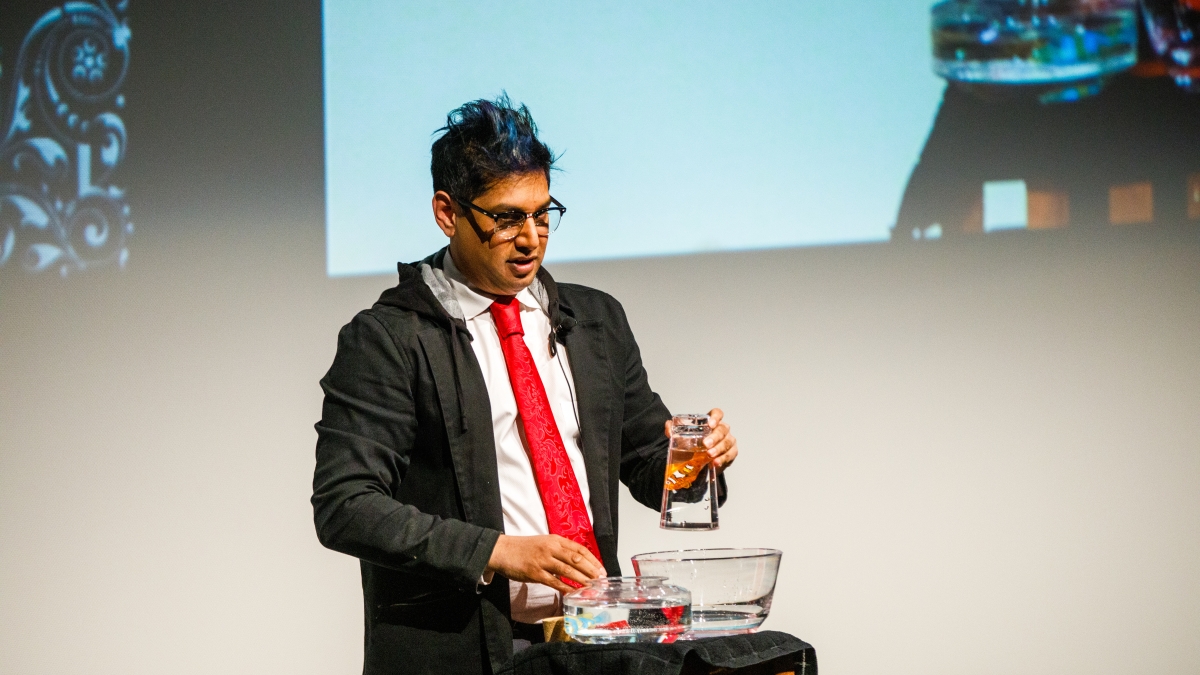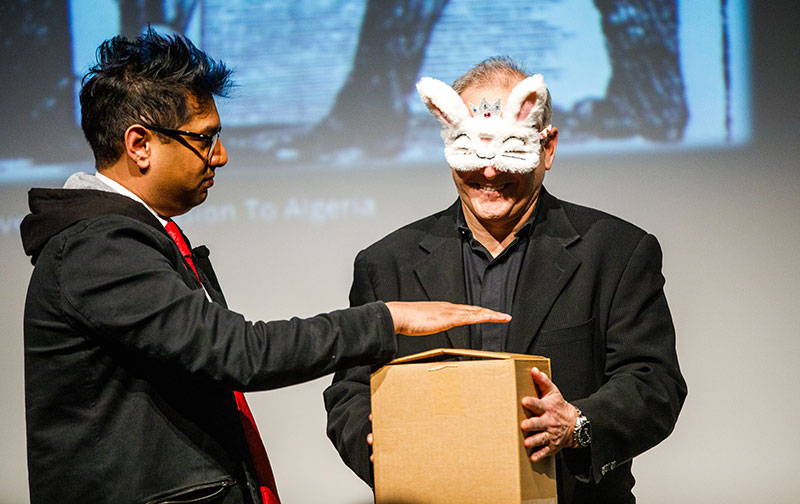Is your brain lying to you?
What magicians can teach scientists about observation

Parag Mallick is a computer scientist and researcher at Stanford Medicine and a world-renowned magician.
Observation is one of the most powerful tools that scientists use. They meticulously perform experiments, analyze data and interpret the results, then repeat that process hundreds of times.
But what if our brains are lying to us? Can scientists trust their observations?
Parag Mallick, a computer scientist and researcher at Stanford Medicine and a world-renowned magician, explored these questions during a recent visit to Arizona State University. In “An Evening of Science and Magic,” sponsored by ASU’s Biodesign Institute, Mallick explained the concept of inattentional blindness to a full house at the Marston Exploration Theater.
What is inattentional blindness, and what can magicians teach us about science? Plenty, according to Mallick.
Inattentional blindness occurs when an individual fails to perceive objects or events because their attention is focused somewhere else. Magicians are experts at taking advantage of this gap in perception. Sometimes scientists may fall victim to this, researching the wrong thing at the wrong time because it made sense at the time to look at it.
“By being extremely cognizant of these gaps in perception, we might do a better job of avoiding them and interpreting our observations,” he said. “We then can do a better job of designing better experiments by becoming aware of these holes in our perceptions.”
Biodesign Institute Executive Director Joshua LaBaer (left) participates in a trick during Parag Mallick's "An Evening of Science and Magic" event. Photo by Andy DeLisle/ASU
Mallick became enamored with magic as a child when he was gifted a magic kit. His childhood hobby transformed into something more serious during college and graduate school when he formed a juggling group called Students Against Gravity. He also began taking classes at the Magic Castle in Hollywood, a clubhouse for the Academy of Magical Arts. He spent years perfecting his craft and started doing magic all over the city and eventually all over the world.
Mallick, now an associate professor who heads a cancer research lab at Stanford University, believes in tackling the impossible. He said magicians have long been willing to embrace the ludicrous in their performances, and this frees up their mind to explore more possibilities. Scientists should do the same.
“Scientists are in the habit of taking things that are impossible and making them possible,” Mallick said. He said a very good magician is meticulous. Just like a scientist will perform an experiment over and over again, a magician will repeatedly practice a trick until he or she perfects it. The extreme attention to detail for both professions results in the greatest successes of today.
“When you embrace the completely ludicrous to find inspiration, it frees your mind and you’re allowed to explore a much wider swath of possibilities,” Mallick said.
Joshua LaBaer, executive director of the Biodesign Institute, was excited to have the Science and Magic event come to ASU because it forces scientists and others to think outside of the box.
Joshua LaBaer volunteers for a trick during Parag Mallick's "An Evening of Science and Magic" lecture show. Mallick is a computer scientist and researcher at Stanford Medicine and a world-renowned magician. Photo by Andy DeLisle/ASU
“Research is all about discovering new things, including new patterns,” he said. “For scientists and researchers, we need to always remember that we cannot take the mental shortcut of assuming that what we see must be part of the previous pattern.”
LaBaer said science and magic are two places where we need to break the pattern-recognition process.
“We like to think of our brain as an open, unbiased instrument that collects data from our senses and then fully analyzes and interprets them. But, in fact, in order to reduce work and enhance response time, our brain cheats a little,” he said.
As a scientist, even if the data suggests the previous pattern, he said, it’s lazy to accept this without proving it.
“It is the magician’s job to trick us into believing the impossible explanation,” LaBaer said. “It is the scientist’s job to determine which explanation is correct.”
Throughout the evening, Mallick performed magic tracks that included holding a glass of water upside down without spilling any water, and solicited volunteers from the audience for a game of three-card monte and other card tricks. He closed his show by addressing some of the gaps in perception that the audience may have missed, which was met with wonder and applause by young and old alike.
Lastly, he reminded the audience that scientists are indeed making tremendous progress and saving many, many lives from cancer and other illnesses.
“I dare anyone to prove me wrong,” he said.
More Science and technology

The science behind chronic stress
Stress comes in many shapes and sizes. There’s the everyday stress of preparing for a final exam or being stuck in traffic. And…

ASU planetary scientist to be inducted into the National Academy of Sciences
The National Academy of Sciences is inducting School of Earth and Space Exploration Director Meenakshi Wadhwa into the 2023 class…

Unlocking the potential of AI for homeland security
“Can we do what we're doing now cheaper, more efficiently, more effectively?” Adam Cox, director in the Office of Strategy and…

